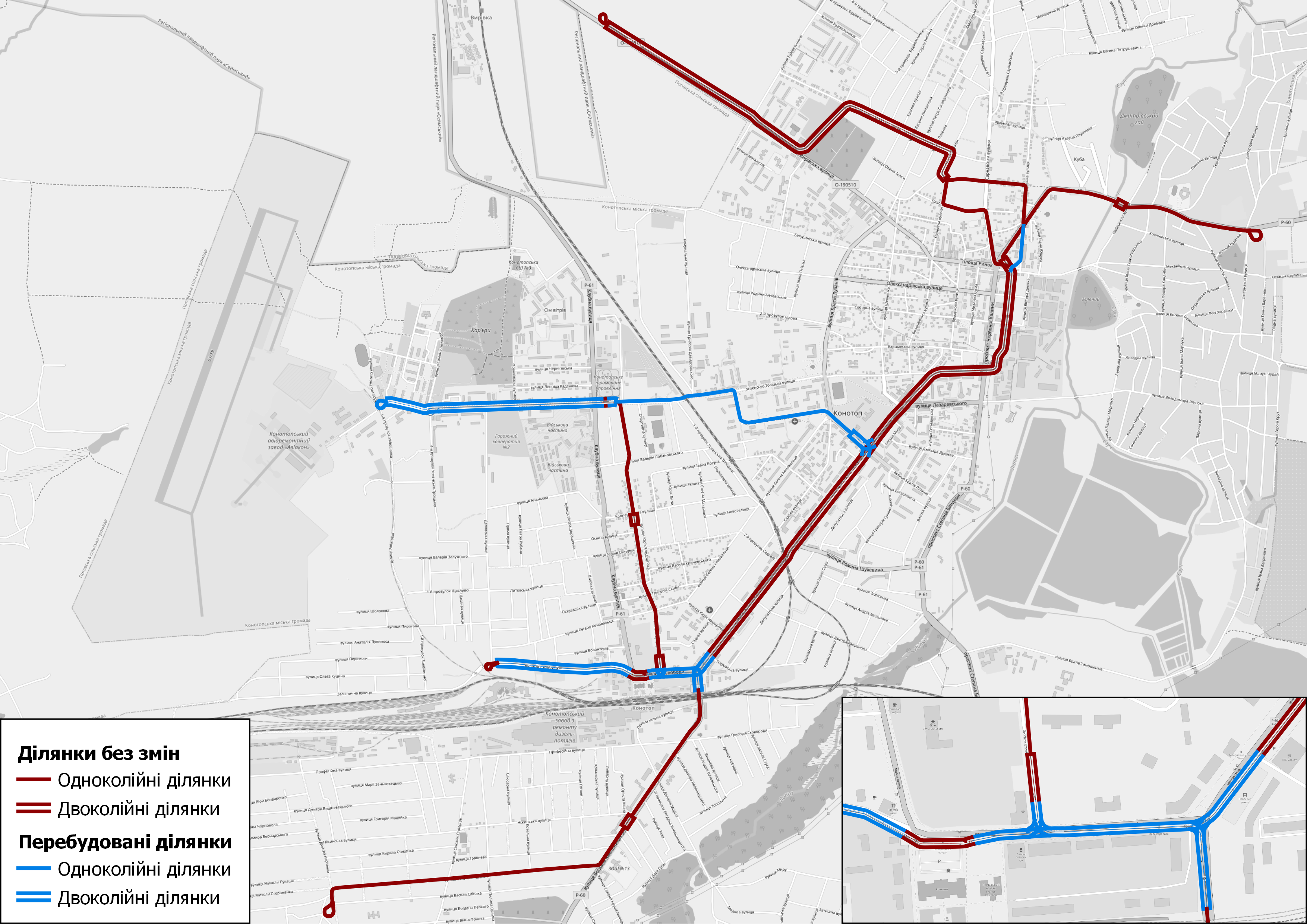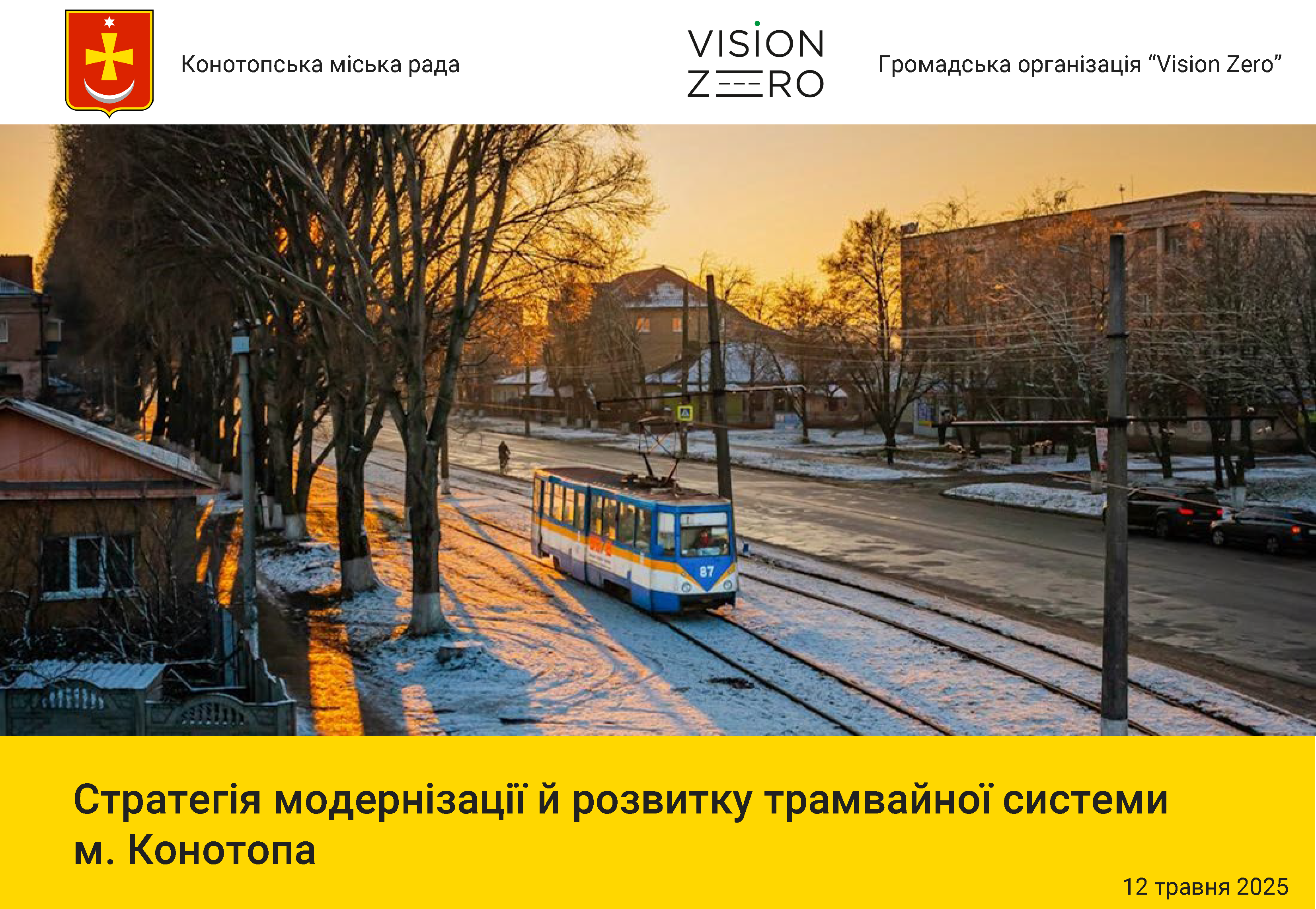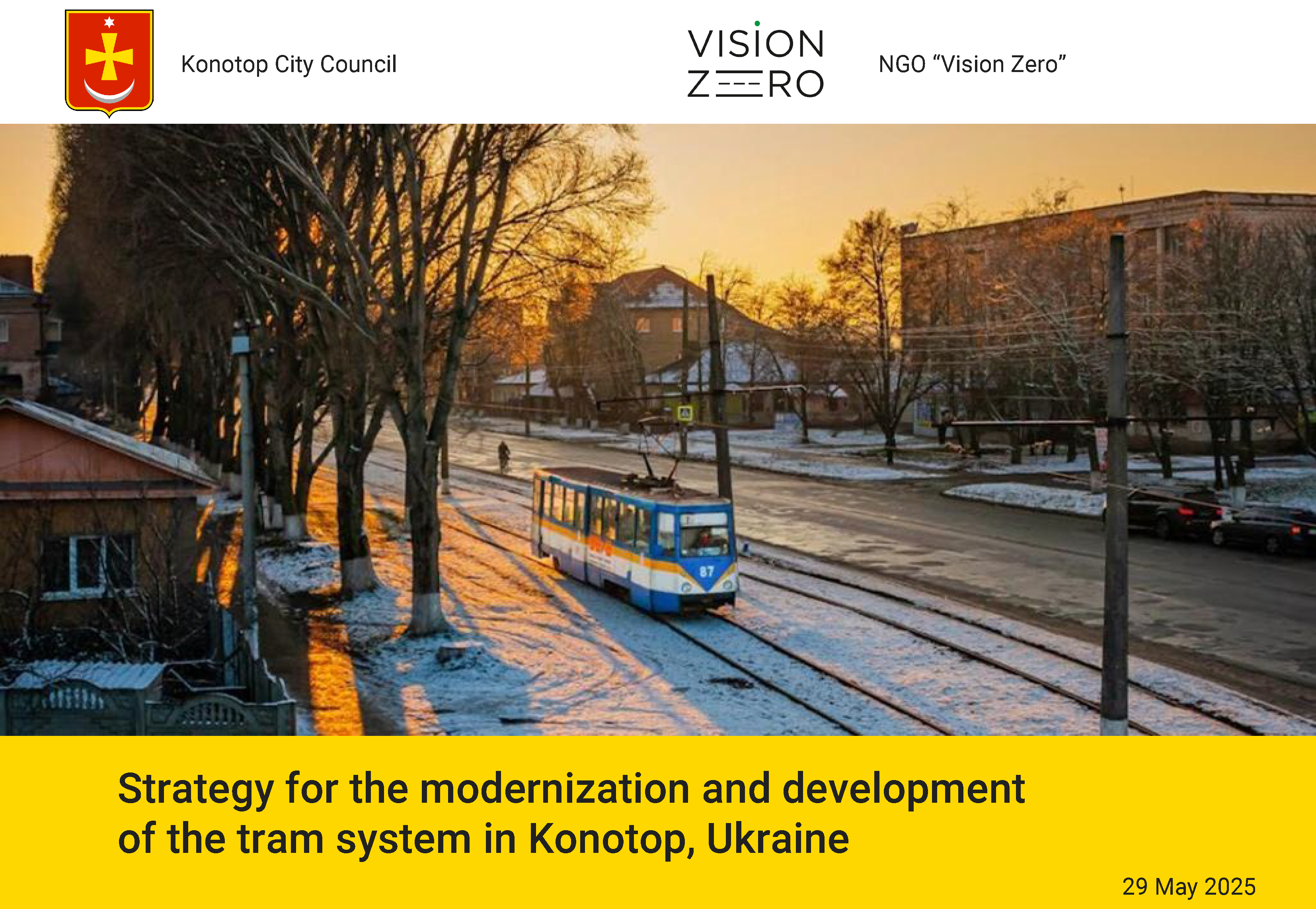
The Konotop tram system is a unique phenomenon. It was created after World War II as a project to restore and modernize the city. The infrastructure was built by the community itself using the "people's construction" method on city-wide roads during 1949.
Over time, the rolling stock has been updated, and the network has expanded from 3 to 27 km. The city seeks to preserve and develop its unique tram system, which requires a strategic approach based on successful EU practices.
The Strategy for the Modernization and Development of the Konotop Tram System was developed with the expert support of the NGO “Vision Zero” in 2024-2025. The document defines a long-term vision for the tram network. The Strategy contains an analysis, defines goals and objectives, and also offers a sequence of implementation and recommendations for increasing the energy efficiency of the municipal enterprise.
Vision of the future
In 2050, Konotop's tram system is the foundation of the city's mobility: it is a modern, integrated, energy-efficient mode of transport, providing fast and comfortable travel for all residents. The system is completely new, although it includes well-restored and preserved elements from the past.

Development principles:
1. Maximum preservation of the existing network - development is carried out with maximum reliance on existing tracks in order to avoid high costs and preserve the historical and functional value of the system.
2. Focus on serving dense development and points of attraction - priority is given to routes and sections that provide connections to areas with high population density, large enterprises, educational and medical institutions, administrative and cultural centers.
3. Increasing the efficiency of the network - attention is paid to reducing delays on routes, reducing traffic intervals, stability of schedule compliance, tram priority at intersections, and reducing operating costs through technical modernization.
4. Integration with the bus network - the formation of a single public transport system, where the tram serves as the backbone of the network, and buses provide coverage of remote areas.
5. Intermodality - connection with external transport hubs and convenience of transfers.
6. High standard of infrastructure - ensuring high quality of rail laying, which allows to increase technical speed and smooth running. Minimization of noise and vibrations through the use of modern technologies.
7. High requirements for the quality of passenger infrastructure - the goal is to ensure barrier-free stops and tram cars, the presence of covers, benches, timetables and lighting.
8. Realism of implementation and cost-effectiveness - solutions must meet the financial and institutional capabilities of the city, the state, and international partners, taking into account the attraction of external grant funding.
9. Improvement of related urban infrastructure - the reconstruction of the tram network should be used as an opportunity for a comprehensive renovation of streets, including engineering networks, hard surfaces, artificial lighting, and bicycle infrastructure.
Strategic goals
The city of Konotop has identified five strategic goals for the modernization and development of the tram system:
Goal 1. Safe tram network
The city aims to achieve zero accident rates on tram routes and completely eliminate accident-prone areas. This includes all types of accidents, including traffic accidents and power system failures.
Goal 2. Achieving the European level of services
As a result of modernization and development projects, the system will provide transport services that meet European standards of service level (Level of Service), in particular: frequency, speed, reliability, convenient pedestrian accessibility to stops (within a radius of 300-500 m), adherence to the timetable, availability of route information, integrated fare payment system, and barrier-free access.
Goal 3. Energy efficiency and resilience to crises
Formation of a tram system that consumes a minimum of energy per unit of transport work performed and is able to maintain functionality in conditions of natural or man-made emergencies.
Goal 4. Modernized infrastructure according to EU standards
Complete renovation of the track and energy infrastructure in accordance with European technical, environmental and safety standards, as well as a new (reconstructed) depot, proper arrangement of stops, turning circles, toilets and rest rooms for drivers, etc.
Goal 5. Full accessibility for all user groups
In the future, Konotop Tram will ensure the accessibility of its services for people with reduced mobility by producing at least 50% of low-floor cars on each route and ensuring barrier-free infrastructure at stops, including the presence of boarding platforms at the entrance level to the car.
EU successful practices as inspiring examples
The tram network in Daugavpils, Latvia (population 80,000) is almost the same age as Konotop, opened in 1946 and 33 km long. It is operated by the municipal enterprise SIA "Daugavpils satiksme", established in 2014 by merging the city's tram and bus operators. The enterprise operates 5 tram routes with a total length of 27 km and operates 45 cars, including KTM-5, Tatra T3D, 71-911 "City Star" models and the latest EVO1, assembled at the local locomotive repair plant "Daugavpils Lokomotīvju Remonta Rūpnīca" in cooperation with Czech partners. The company also operates 33 bus routes and operates about 60 buses. The company employs about 500 people and has an annual budget of about 10 million euros. About 45% of trams and all buses are low-floor.
Trams in Daugavpils in 2021 (source Wikipedia )
The tram network in Liepāja, Latvia (population 66,000) is the oldest in the Baltic States, opened in 1899. Currently, the city has one tram line, 7.9 km long, serving 18 stops. The tram network is operated by the municipal enterprise SIA "Liepājas tramvajs", founded on 14 October 1992. In 2023, the average number of employees was 80 people. The enterprise paid 1.32 million euros in taxes to the state budget, including 201 thousand euros in personal income tax and 389 thousand euros in social contributions. The tram fleet consists of 23 cars, including both old Tatra KT4 models (obtained second-hand from Germany) and 14 new low-floor TMK 2300 LT trams manufactured by the Croatian company Končar. The delivery of new cars was completed in November 2022 as part of the "Comprehensive Reconstruction of the Tram Route and the Surrounding Area" program worth almost 21 million euros, partially financed by the EU.
Tatra KT4 tram in Liepaja. Author: Kārlis.Paikens, alltransua.com
In Frankfurt (Oder), a German city on the border with Poland with a population of 60,000, trams have existed since 1898. The network currently consists of five routes with a total length of 37.9 km, serving 42 stops. The operator is the municipal company Stadtverkehrsgesellschaft GmbH Frankfurt (Oder) (SVF), founded on July 1, 1990. The company also operates the city's bus network. The tram fleet includes 15 Tatra KT4DM cars, 8 GT6M low-floor cars and 13 new Škoda ForCity Plus 46T cars, deliveries of which began in 2024. The bus fleet consists of 26 buses, mainly MAN, including hybrid and liquefied natural gas powered buses. There are 10 bus routes in the city, including two night routes. The total length of bus routes is 113.3 km, with an additional 22.6 km of night routes.
Tatra KT4DM tram in Frankfurt/Oder. Author: Matel6380, alltransua.com
More information in the project materials and the text of the Strategy
Files for viewing and downloading (PDF):
About the project:
The materials were developed within the framework of the project “Climate-neutral and accessible transport infrastructure of Konotop”, implemented by the NGO “Vision Zero” from 01.11.2024 to 31.05.2025. The project was implemented in cooperation with the Konotop City Council within the framework of grant support from the European Climate Foundation . Responsibility for the information and views expressed in this document lies with its authors. The European Climate Foundation cannot be held responsible for any use of the information set out in this Strategy and does not necessarily share the opinions, assessments and conclusions expressed in it.
The following worked on the project:
From the side of the city of Konotop: Mayor Artem Semenikhin, Deputy Mayor Svitlana Samsonenko.
KP “Konotop Transport Department”: Director Viktor Tymoshenko, Acting Director Natalia Yablonska, Chief Engineer Serhiy Tyagniy.
Department of Urban Planning and Architecture: Olena Sydorenko.
Economics Department: Olena Kovalenko.
From the public organization “Vision Zero”: Chairman of the organization's board and project manager Viktor Zagreba, coordinator Kateryna Lozovenko; expert team: Anton Gahen, Yuriy Lozovenko, and Artem Polyukh.
Cover photo: Konstal 105Na tram, alltransua.com


